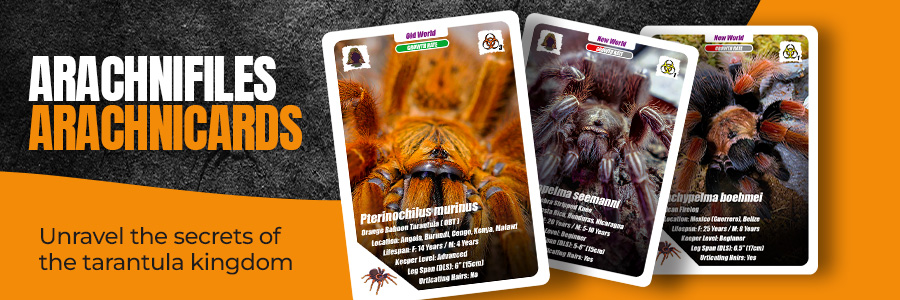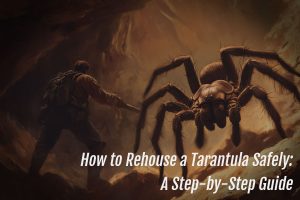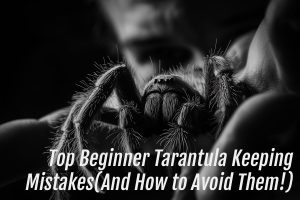Aphonopelma seemanni also known as the Costa Rican Zebra or Stripe Knee Tarantula
If you’re into tarantulas and looking for a new addition to your collection, the Aphonopelma seemanni, also known as the Costa Rican Zebra or Stripe Knee Tarantula, might be the perfect fit for you.
Info Overview
Genus: Aphonopelma
Species: seemanni
Common Name: the Costa Rican Zebra or Stripe Knee Tarantula
Living Height: Terrestrial / Opportunistic Burrower
Urticating Hairs: Yes
World Type: New World
World Location: Costa Rica, Honduras, Nicaragua, and other parts of Central America
Leg Span (DLS): 5 to 6” (15cm)
Life Span: F: up to 20 years M: up to 10 years
Growth Rate: Slow
Keeper Level: Beginner
About
This terrestrial New World species is commonly found in Costa Rica and Central America, specifically in the warmer and drier northern areas. Although it can be defensive, the Aphonopelma seemanni is not considered docile and will retreat to its burrow instead of kicking hair or giving a threat pose.
Females of this species can live up to 20 years and reach maturity in 5-6 years, while males live for about 7 years and reach maturity in 2-3 years. Females can grow up to 5-6 inches, with males being slightly smaller. They have a dark brown coat with bright white or beige-colored stripes along their legs, giving them their “Zebra” and “Striped-Knee” common names.
As spiderlings, Aphonopelma seemanni spends the majority of their time burrowed deep into the substrate, occasionally coming out to feed or drink. Once they are over 3 inches, they tend to spend more time out in the open. However, even as adults, they prefer the ability to burrow and can stay hidden in their burrow for months at a time.
Enclosure
If you’re interested in keeping an Aphonopelma seemanni, here are some tips on how to properly care for them. For spiderlings, use a basic spiderling enclosure with at least 2/3 of the enclosure filled with substrate. Keep the substrate slightly damp and provide a small water dish if possible or drip water down the side of the enclosure for slings under 0.75 inches. For juveniles, move them to a basic juvenile enclosure with at least half to two-thirds of the enclosure filled with substrate, along with a hide and water dish. Keep the water dish full and overflow it slightly every few weeks, making sure not to flood their burrows.
Adults should be kept in 5 or 10-gallon terrestrial enclosures with more width than height, with at least half the enclosure filled with substrate. This species does not have a preference for dry or damp substrate, but if kept too damp, it can lead to mold and mushrooms growing. Provide a hide and decorations, and make sure there is not much room between the top of the enclosure and the floor, as Aphonopelma seemanni have the propensity to climb up the sides of the glass and across the top of the enclosure.
Feeding
When it comes to feeding, give small slings under 0.5 inches flightless fruit flies or confused flour beetles twice a week. Once they are over 0.5 inches, give them small crickets or pinhead roaches and pre-kill the prey if it looks too big. For juveniles, feed one or two small-medium crickets every 10-14 days. This species can refuse to eat for weeks or even months at a time, especially when in premolt. After a molt, wait about 4-7 days before attempting to feed.
Adults should be fed 4 or 5 adult crickets every three or four weeks. Although they have an amazing feeding response, they are skittish and will usually bolt into their burrow when the enclosure is opened. Drop in the feeders and let them roam around for a bit. Within a few minutes or hours, the tarantula will usually resurface and feed. If not, remove the feeders 24 hours later and attempt to feed again in a week or two. Remember, this species can go months without eating, so if they’re not showing any interest in food, they may be in premolt.
Conclusion
In conclusion, the Aphonopelma seemanni, commonly known as the Costa Rican Zebra or Stripe Knee Tarantula, is a fascinating species that can be found in the dry forests of Costa Rica and Central America. While they may not be the most docile tarantulas, they are beautiful creatures that can live up to 20 years in captivity. By providing them with the proper enclosure, substrate, and feeding schedule, you can ensure their health and well-being. However, it’s important to remember that these tarantulas prefer the security of their burrows and may go months without eating, especially when in premolt. So be patient and let these amazing creatures live their lives in peace.
Other Helpful Info!
If you found this post helpful, please consider sharing it. It really helps the site in the search algorithm! Thanks!
Do you have inverts and arachnids? Want a fun way of tracking them? Then download Arachnifiles for Android or iOS today! It’s free!
Want to read more about invertebrate care? Click here to view other care guides!
If you’d like to watch The Tarantula Collective talk about this tarantula, you can watch it here!




